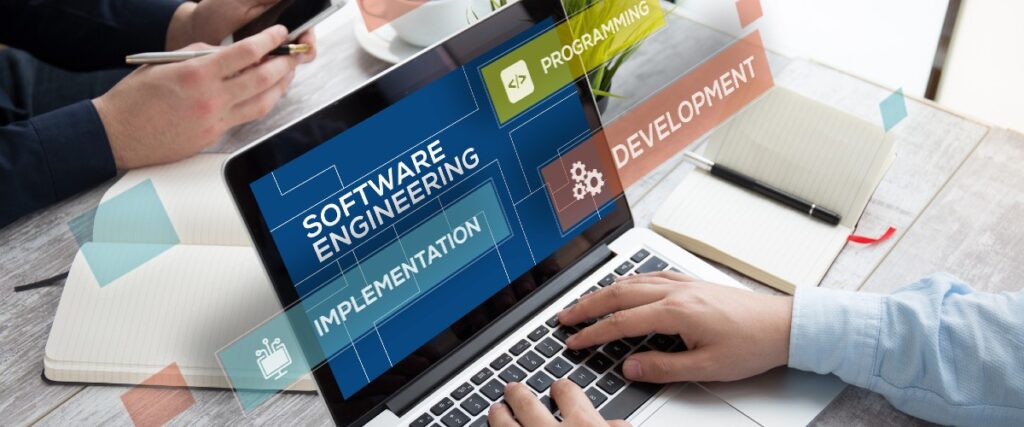From small businesses to the largest corporations, software powers complex workflows, enterprise planning, shipping and logistics, hardware maintenance, patient diagnosis, and countless other processes across the economy.
Ensuring all software functions as intended without introducing unforeseen risks to the user is a significant responsibility with dire consequences if not taken seriously. The solution to this is software validation.
What Is Software Validation?
Software validation is a straightforward concept. Professionals use it to determine whether a new digital system operates as expected and fulfills the task for which it was chosen or designed.
Enterprises worldwide are expected to spend $672 billion on information technology in 2022.
Having a process for appraising and vetting the huge selection of enterprise-grade IT products helps companies save considerable time and effort. The same logic applies to developing new software in-house.
Software Development Timeline
Validation fits neatly into the larger software deployment timeline:
- Conception and planning
- Requirements and design
- Development and testing
- Software validation
- Deployment
A good software developer will have a validation plan tailored for the specific project before beginning and documents outlining specifications and requirements.
What Are the Steps of Software Validation?
There are three individual steps to take during software validation.
- Installation qualification (IQ): This is a validation of the new software installation, supervised by the IT or technical team. It includes steps for deploying the software, including verification checks and documentation at each stage.
- Operational qualification (OQ): This focuses on how the system operates and fulfills the needs of business operators. OQ provides operational testing of all software functions using test cases.
- Performance qualification (PQ): This involves a mix of technical and business-side staff. It involves stress tests to see how the system operates during peak demand.
Some of these phases involve their own steps, including installation qualification. Software professionals should have a detailed IQ protocol for each project, including inventories, assessments, and backup and recovery plans.
These steps may be repeated as necessary. A successful software validation process culminates in a report detailing any deviations plus evidence to back up claims or direct the development of new software builds.
Steps three and four from the first list above may be repeated until the software meets all the functionality, performance, and security requirements laid out in step one.
How Does Software Validation Apply to Regulations?
Some regulatory bodies require specific industries to use software validation. It’s a good idea to adopt it even when this is not the case.
According to the U.S. Food and Drug Administration (FDA), companies must use software validation in cases where it can impact the safety or quality of a manufactured product. Examples of applicable products include:
- Foods and beverages
- Pharmaceutical products
- Medical devices and implants
- Dental, surgical and ophthalmological equipment
- Diagnostic chemicals and compounds
- Food or drug ingredients and additives
The FDA’s complete software validation principles last received an update in 2019.
Directives set by the federal government cover some sectors but not all. Software validation benefits industries and those listed here for reasons beyond regulatory compliance.
How Does Industry Benefit From Software Validation?
Some industries are more heavily regulated than others, which means certain companies should deploy software validation techniques as a matter of course.
The Benefits of Software Validation
Here is a look at why businesses should take it seriously.
- Quality and consistency: Achieving consistent quality in foods, beverages, pharmaceuticals, and medical devices is of the utmost importance. 2020 saw almost two-dozen medical device recalls in the U.S. — a deceptively small number with a huge toll on human life. Software is frequently used in fabrication and inspection, so it must be up to the exacting task of producing consistent results.
- Safety and performance: Every product on the market must do what it says it does. Software that helps manufacturers vet their business partners, map their supply chains, monitor their assembly lines, and track metrics for perishable goods must be chosen carefully. Many variables can affect product performance, and tracking them requires reliable, well-built software tools.
- Reputation and recordkeeping: Several phases in software validation require step-by-step documentation for successes and failures. Requiring detailed recordkeeping in the software deployment process creates a paper trail of proof that companies performed their due diligence. Culturally, it may inspire a similar approach in other business areas. Doing this in software-heavy environments is also vital for observing cybersecurity laws.
Software Validation: A Simple Concept With Manifold Applications
Companies have every reason to safeguard their reputations and competitiveness these days, and sometimes that starts with recommitting to the basics. Software validation is a simple but powerful tool even in sectors where it’s not required.
It merges the logic-driven technical team with the results-focused business team, ending with something that meets technical requirements, supports business processes and growth, and mitigates industrial and cybersecurity risks.
